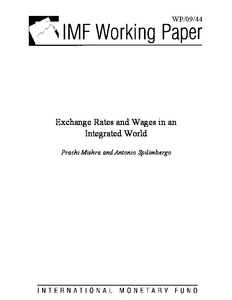Exchange rates and wages in an integrated world
"We analyze how the pass-through from exchange rate to domestic wages depends on the degree of integration between domestic and foreign labor markets. Using data from 66 countries over the period 1981–2005, we find that the elasticity of domestic wages to real exchange rate is 0.1 after a year...
| Main Authors: | , |
|---|---|
| Institution: | ETUI-European Trade Union Institute |
| Format: | TEXT |
| Language: | English |
| Published: |
Washington, DC
2009
IMF |
| Subjects: | |
| Online Access: | https://www.labourline.org/KENTIKA-19188379124919065519-exchange-rates-and-wages-in-an.htm |
| Summary: | "We analyze how the pass-through from exchange rate to domestic wages depends on the degree of integration between domestic and foreign labor markets. Using data from 66 countries over the period 1981–2005, we find that the elasticity of domestic wages to real exchange rate is 0.1 after a year for countries with high barriers to external labor mobility, but about 0.4 in countries with low barriers to mobility. The results are robust to the inclusion of various controls, different measures of exchange rates, and concepts of labor market integration. These findings call for including labor mobility in macro models of external adjustment." |
|---|---|
| Physical Description: | 42 p. Digital |

